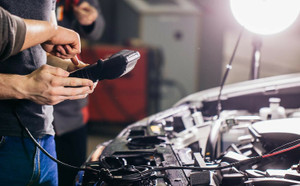Car battery issues? A guide to your car's electrical system
By Kijiji Autos
Getting into a car and starting off on a drive has remained pretty much the same over the decades. But these days, everything—the ignition, the air conditioning, the satnav and more—is tied to the electric system of the car, which is the “brain” of it all.
We’re not going to get into every aspect of a modern car’s electrical system because there are just so many variations. But we’ll cover the basics that most of them share so that you can better diagnose any issues with your own car.
Finding your car’s electrical system scheme
To be able to assess what might be wrong with your car, you’ll need to have its electrical system scheme on hand. Luckily, there are numerous sites out there where you can download the right scheme. These sites also tend to have a huge database detailing each component, the possible problems based on the dashboard warning lights and how to fix them.
There are five key aspects of your electrical system:
The battery is the “heart” of the system, supplying energy to everything else in the car. Its voltage is (unsurprisingly) measured in Volts, while the battery’s capacity uses Amperes (“amps”). It’s important to have an idea of the battery’s voltage: If the dashboard light comes on or you’re experiencing slow starts, it might be low on charge. Batteries typically last about four to five years.
Another key component for quick engine starts is the starter motor. This uses up a high amount of battery in short bursts to get the engine going, with enough revs for the engine to then run on its own. A starter motor consists of a small electric motor, an electromagnet, and a pinion gear. If any of these parts fail, your car won’t start at all.
The alternator transforms mechanical energy into electrical energy via alternating current. This is a crucial function, providing charge for the battery and power for the various in-car devices.
Power travels from the alternator to all of these devices via cables. Typically, red or orange cables carry a positive voltage, and black or green are ground wires. Cables will have different diameters based on the amount of electricity they need to transport. And connectors? Well, simply put, they connect the cables to the devices.
What if my battery goes flat?
If your battery has gone flat after only a few days, there’s likely a problem with the electrical system. You can charge a battery with a dedicated battery pack, or jumpstart it with another car—just remember that you can’t jumpstart a hybrid.
Once the battery is charged up, you can test it with a handheld multimeter: Make sure to connect it to your battery according to the multimeter instructions. If the charge goes up after the engine is running, there may be a problem with the battery itself. Meanwhile, if the charge decreases after start-up, that points to a likely alternator issue. Most auto shops will test either part for free if you bring the car in.
That’s a solid foundation to better understand your car’s electrical system. Interested in reading about other common issues? Check out the Kijiji Autos guide on pinpointing annoying rattles.
Ready to start the search for your next car? Browse thousands of cars on Kijiji Autos’ mobile app to find just the one for you.
Easily find your next ride on Kijiji Autos
Search nowHow Long Can a Car Sit Unused?
How long can a car be left without starting it? Keep reading to explore everything you need to know about unused cars.Costs of Installing an Electric Car (EV) Charging Station in Canada
Installing a home EV charger can come with additional fees beyond purchase and installation. Here's a list of factors that can affect the price of a home EV charger.Toronto to Calgary Road Trip: Routes & Tips
Planning on driving from Toronto to Calgary? Here are some routes and tips to help you along the way.Flat Tire vs Blowout: What's the Difference & What Should You Do?
The main difference between a flat tire and a blowout is that a blowout often feels like an explosion has occurred underneath your vehicle. Blowouts can cause sudden and drastic changes to the handling of your vehicle and can lead to minor or even serious accidents.7 items you can fit in an SUV: TVs, mattresses and more
Discover seven common items that fit in an SUV below.Tips to help protect your vehicle and budget for car repairs
When shopping for your next vehicle, it's always a good idea to keep hidden costs in mind. Before you buy, let's look at how much it can cost to maintain a car in Canada, how much you could budget for annual maintenance and repairs, and how to help protect your car against damage and depreciationThe top three best paint protection options for your vehicle
Buying a new vehicle is a great experience. Nothing beats hitting the road in a car you bought fresh off the lot. However, as fun as it is to finally get behind the wheel of your new ride, it's important to take your time through the process.What is the value of undercoat protection on your vehicle?
When you buy a new vehicle, protecting it so that it lasts as long as possible is definitely top of mind, whether that's through security upgrades or an extra coat of paint. But how often do you consider the care and safety of your vehicle’s undercarriage?Financial guide: post-pandemic car shopping and gas price hacks
With populations locked down and international borders closed the global supply chain has been disrupted on a massive scale, pushing up inflation around the world and raising the cost of everything that people need to get back to normal. Here are a few tips you can use to grab the vehicle you want without breaking the bank.10 tips to help make the road a better and happier place
We have all, at some point, been responsible for making the roadways stressful in one way or another. Alternatively, we are all equally capable of making the road a happier place. Let’s explore 10 unique ways we can help make the driving experience better again, for everyone's sake.








